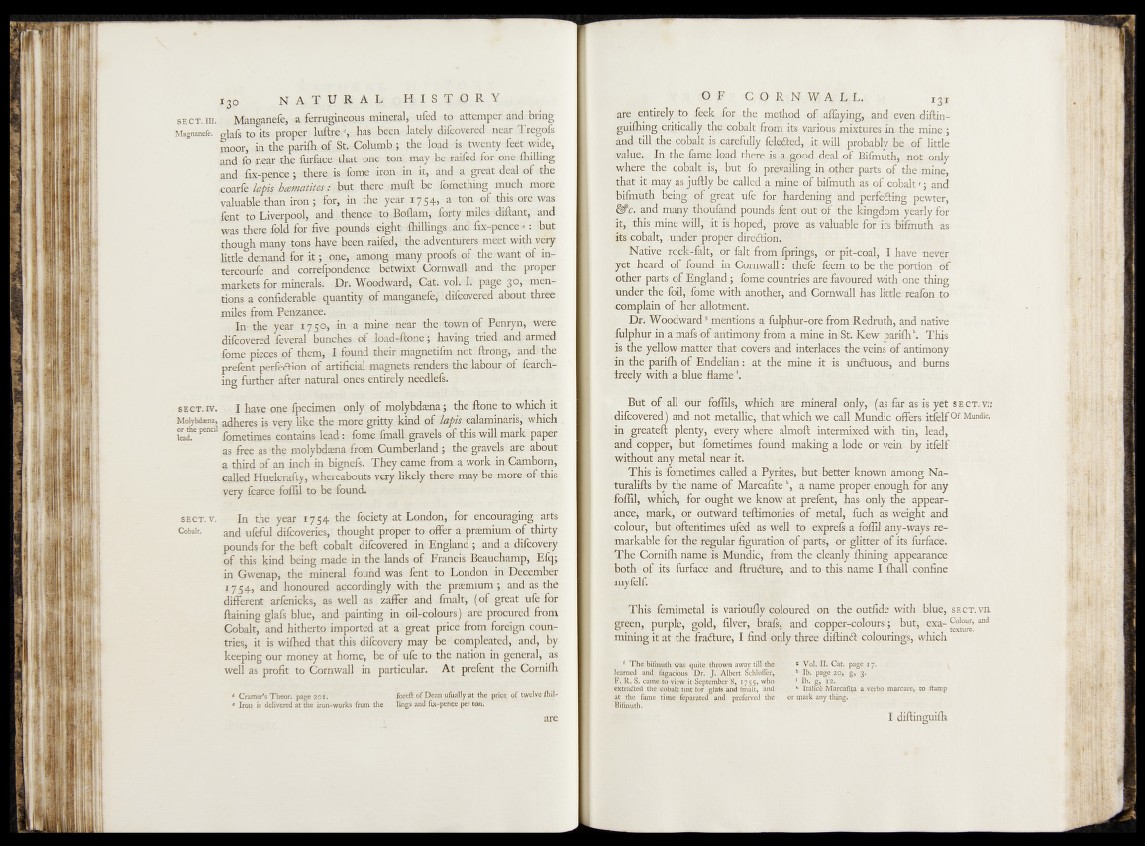
SECT., in.
Magnanefe.
SECT. IV.
Molybdæna,
or the pencil
lead.
SECT. V.
Cobalt.
Manganefe, a ferrugineous mineral» ufed tc attempers and bring
glafs to its proper lufhe ', has been r lately difeovered nearTregofs
moor, in die p a r i f l i } the lo^d, :fef!twmty feet mde,
and fo near the furfacethat one ton may he :raifed for one foiling
and fix-pence; there is fome iron, in it, and || great deal of ithe
coarfe lapis hcematites: .but there muff be fomething much more
valuable than iron; for, in the year 1754, a ton of this ore was
lent to Liverpool, and thence tQ.-Roflam, forty miles diiftant, and
was there fold for five pounds eight /foldings: .and fix-pence«: hut
though many tons have been r ^ ^ h t i e adventurers meet sra^1
fitjie demand for i t ; one, ; among, . many proofs o f the want of in-
tercourfe and correspondence betwixt Cornwall and the proper
markets for minerals. Dr. Woodward', Cat. yol. I. page 3-0* mentions
a confiderable quantity, of m&nganefey 1 difeovered about three
miles from Penzance. - ii
In- the year 1 7 5 ^ .in a nnne! near the- town of Penryn, were
difeovered feveral bunchy of ioadtftone; having tried; and armed
feme pieges o f them, I found their magnetifm -nbtf ftrdng, and) the
prefent pafedion of artificial magnets: renders the lajbour .'of fcarch-
ing further after natural ones entirely needlefs.
I have one fpedmen only of molybdaena; tjie ftone to which it
adheres is very like the more gritty kind o f edaminaris, which
fometimes contains lead: fome finall gravels of this will mark paper
as free as the molybdasna from Cumberland ; the gr&yels! are about
a third of an jneh in bignefs. They came from a work iqiGaimbom,
galled Hnelerafty, whereabouts verylikely there may .be: more of this
yery fcarce foffil tp be found.
jn the year 1754 the fbciety at London, for encouraging arts
and ufeful difeoveries, thought-proper to offer a premium of thirty
pounds for the heft cobalt difeovered in England; and a difeovery
o f this kind being made in the lands of Francis Beauchamp, Efq;
in Gwenap, the mineral found was fent to London in December
1754, and honoured accordingly with the prasmium; and as the
different arfenicks, as well as zaffer and finalt, (of great ufe for
{pining glafs blue, and painting in oil-colours) are procured from
Cobalt, and hitherto imported at a great price from foreign countries,
it is wifoed that this difeovery may be compleated, and, by
keeping our money at home, be of ufe to the nation in general, as
well as profit to Cornwall in particular. At prefent the Cornifh
4 Cramer’s Theor. page 20% '. •' foreft of Dean ufually at the price, of twelve fliil-
' Iron is delivered at the iron-works from the lings arid fix-pence per ton.
are
are entirely to feek for the method of allaying, and even diftin-
guifhing critically the cobalt from its various mixtures in the mine ;
and till the cobalt is carefully feledted, it will probably he of little
value. In the fame load there is a good deal of Bifmuth, -not only
where the cobalt is, but fo prevailing in other parts of the mine,
that it may as juftly be called a mine of bifmuth as of cobalt r; and
bifmuth being of great ufe for hardening 'and perfedting pewter,
&*c. and many thoufand pounds fent out of the kingdom yearly for
it,.' this; mine will, it i's.hoped,' prove as yalhable for its taferath as
ksjpdb$lt, .under proper diredfidph;’^
J Native roek-falt, or lalt from iprings,’for’“pit-coal, I have nevCr
yet heard of found in Cornwall' : thefe feem to be the5 portion bf
other parts of England ; feme countries are favoured with one thing
under the foii/fome with another, and Cornwall has little mafon to'
complain of her allotment.
Dri Woodward * mentions a! fid|four-orefr0m Redruth, and native
•lulphur in a mafs o f antimony from a mine in St; Kew parifo\ This
js the yellow matter that covers and interlaces the veins o f antimony
in the parifh of Endelian: at the mine it is undluous, and burns
freely with a blue flame *.
But of all our foffils, which arc mineral only,‘ (as far as is yet sect.vk
ijdifcovered) and not metallic, that which we call Mundic offers itfelf ° f Mundic>
in greateft plenty, every where almoft intermixed with tin, lead,
and copper, but fometimes found making a lode or vein by itfelf
without any metal near it.
This is fometimes called a Pyrites, but better known among Na-
turalifts by the name of Marcafite k, a name proper enough for any
foffil, which, for ought we know at prefent, has only die appearance,
mark, car outward teftimonies of metal, fech as weight and
»colour, but oftentimes ufed as well to exprels a foffil any-ways remarkable
for the regular figuration of parts, or glitter o f its furface.
The Cornifh name is Mundic, from the cleanly Ihining appearance
both of its furface and ftrudture, and to this name I fliall confine
myfelf.
This femimetal is varioufiy coloured on the outfide with blue, sECT.vn.
green, purple, gold, filver, braß, and copper-colours; but, exa- ****
mining it at the fradture, I find only three diftindt colourings, which
f The bifmuth was quite thrown away till the
learned and fagaeious Dr. J. Albert Schlofler,;
F. R. S. came to view it .September 8, 1755, who
extra&ed the cobalt tint for glafs and (malt, and
at the fame time feparated and. preferved the
Bifmuth.
t Vol. II. Cat. page 17.
. " lb. page. 20, g, 3.
T * B), g, 12.
k Italicè Marcafita a verbo marcare, to (lamp
or mark any thing. - *
I diftinOguifh